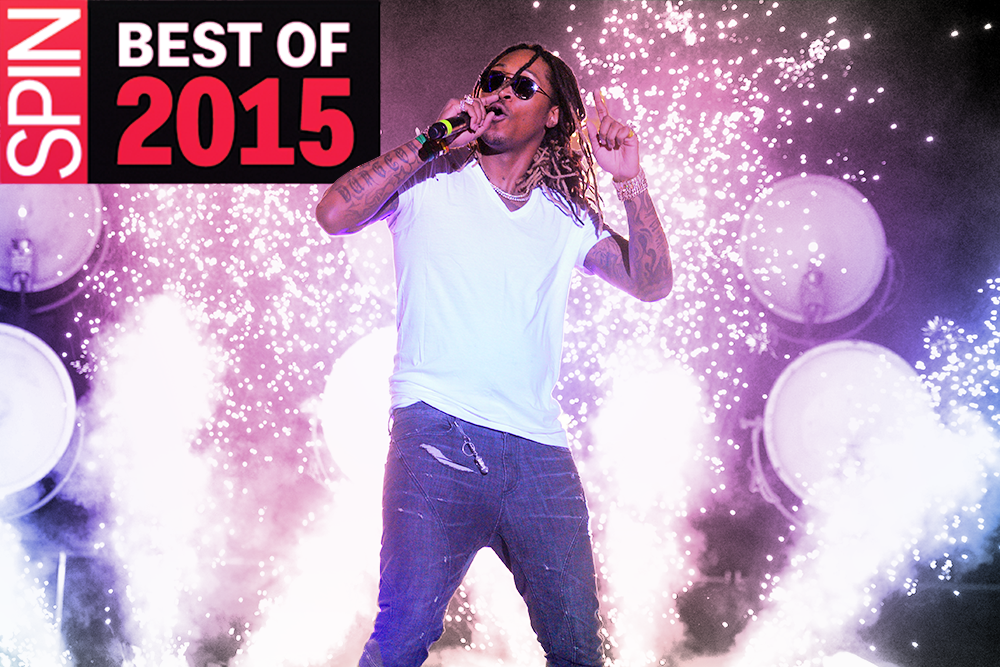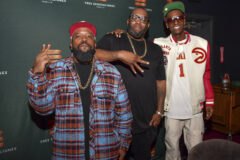Dirty Sprite 2 to me will always signal the first Friday I remember new music being released. There was a slow period in the summer right after the frenzy of Kendrick, Earl, and Tyler all surprise-dropped new records. But July 17 was the first time I can recall circling a Friday in my calendar and thinking, “Yes, new music.” This was the date when the arc of 2015 rap bent in Future’s favor.
[articleembed id=”175065″ title=”Every Future Song of 2015, Ranked” image=”175559″ excerpt=”Future treated hip-hop like his own personal social media platform in 2015, firing off mixtapes, albums, one-offs, and guest verses the way that most people dispense favorites likes on Twitter”]
There are certain moments where reality becomes irreversible: The forward pass is introduced in football. Dylan goes electric. Donda West meets No I.D.’s mother in Chicago. However, there’s an even more scintillating aspect in culture where perception of a public figure changes so drastically that the person becomes unrecognizable. I don’t mean in the sense of Neil Young asking whether it’s better to burn out or fade away — we’ve seen countless rock stars do both, especially the former. Burning out in rock often entails showing up to the MTV Video Music Awards in a hockey jersey with cornrows, or appearing on reality TV. And this isn’t Keith Richards admitting to snorting his father’s ashes, or the Gallagher brothers having another public dispute, or someone tragically dying at the age of 27. It’s when someone typically beloved decides to spurn their belovedness. In wrestling this is called turning heel.
No one’s achieved such a successful public heel turn in recent years quite like Future did in 2015. After years spent in Atlanta churning out excellent mixtapes, guesting on countless rap songs, and bubbling upstream in 2011 with a grassroots hit in the sublimely catchy “Racks,” the artist born Nayvadius Wilburn burned himself into mainstream public consciousness in 2012. That year saw the arrival of his quietly groundbreaking album, Pluto, a record that mixed drugged-out, of-the-moment ATL trap music with earnest romanticism and vulnerability that remains timeless.
Pluto was the striking realization of a sound Future worked toward since 2010, and consequently improved upon via a spate of releases like 2011’s somber True Story. The loneliness in his work was always there — it’s what made his stunning power ballads like “Turn on the Lights” hit so hard. But when a public romance with Ciara birthed a transcendent love song in 2013’s “Body Party” (written with Future and released on Ciara’s self-titled fifth LP) and an adorable baby whose legal name actually is Future, it appeared to cement Future Sr.’s status as maybe a Good Guy who had achieved his artistic vision and found some personal peace.
The result was 2014’s Honest, an album that retroactively seems underwhelming, even misguided, though at the time it was generally well-received. It contains at least two classics in the star-studded “Move That Dope” and “Benz Friendz,” Future’s manic Dungeon Family-reuniting collaboration with André 3000. It also upped the ante of just how willing we were to accept his blunt romanticism, which at times skirted a weirdly off-putting possessiveness — “I Be U” dipped its toes gently in schmaltz, where “I Won” dove headfirst into a semi-icky hook of “I won me a trophy.” The end result was a weird cognitive dissonance, where an artist we all loved for his candor maybe took it too far — he went and named his intended-crossover album Honest. People cannot handle that level of literalism. Honest was, by and large, passed over in best-of 2014 lists.
Then came the public dissolution of Future’s relationship with Ciara. Then came “Pussy Overrated,” a shockingly tasteless song with Wiz Khalifa. (You can guess what that one’s about.) Then came Monster, executive produced by Metro Boomin, which, in the fall of 2014, felt like a dark detour in Future’s discography. Sure, he was going through some personal things, but it seemed like an exorcism more than a fork in the road of his career.
The pivot really manifested itself with January’s Beast Mode, a lean, mean mixtape overseen by producer Zaytoven that’s as indelibly produced as it is emotionally direct, like a break-up letter written in cursive. Not-so-subtly featuring a beating heart on its cover, it’s the work that feels most directly “about” his life post-Ciara. March’s progressive trap-meets-Aphex Twin, 808 Mafia-helmed 56 Nights — technically credited to DJ Esco — is a whirring, bleak set inspired by Esco’s 56 days of imprisonment in a Dubai jail in the winter of 2014 for marijuana possession, but make no mistake: It is of the same emotional tenor as his Monster/Beast Mode tapes, concluding a thematic trilogy that follows the transition into heel-turn Future, before the rapper sealed his fate on the relentless DS2.
Around this time, a curious phenomenon was birthed: #FutureHive. Future fans are of diverse backgrounds but by valorizing Future they turn him into some twisted ideal of hetero-manhood (and an obvious tip of the hat to the #BeyHive, the hashtag for Beyoncé super-fans worldwide). #FutureHive was the devotees’ online playground, where Future fans — some of whom had been following him since 2010 — embellished Future’s drug-and-sex-fueled iconography to god-like status. Even when Future was singing wistfully about love on Pluto, he still called himself an astronaut who, mired in codeine and weed, longed to scrape the stars. His mythology, as a kind of Atlanta-meets-Afro-futurism-meets-strip-club maestro, built itself naturally during Phase One of his career. But after Beast Mode and 56 Nights, Future was no longer an emotional songwriter who rapped but also brilliantly manipulated his Auto-Tune. He was as untouchable an icon as Beyoncé, and since his increasingly dark, decadent run initiated with Monster, his fans not only grew in numbers, but also became more vocal and, frankly, strange (but often hilarious).
As these things tend to do, #FutureHive clicked right at the cusp of his biggest moment in 2015. If you recall, Future moved the release of Dirty Sprite 2 — the sequel to his 2011 Dirty Sprite mixtape — up to July after it was originally slated for a later release. A mere mortal doesn’t speed up the release of an album that’s an hour-long dirge brimming with drug talk (“I Serve the Base”), violence (“Stick Talk”), car analogies gone wrong (“Slave Master”), rich sex (uh, “Rich Sex”), and taking pills with strippers (“The Percocet and Stripper Joint”). DS2 is as direct an artistic statement as one can make — 18 songs on the deluxe version with just one feature, and it’s Drake, the only rapper who was hotter than Future in 2015, but arguably less affecting.
This is an artist who’s been elevated by his most die-hard fans into a myth, who ditched a nuanced, mostly positive public-perception so he could straight-up label himself a “monster.” Across three mixtapes, he chronicled a debaucherous but empty life post-Ciara, who in turn made an introspective record about becoming a mother (May’s tepid Jackie). And there was an album — as diametrically opposite his triumphant Pluto as the muted Honest — to attest to it all. And it wasn’t released to shrugs. It didn’t get the same passive reception as Honest. It debuted at No. 1 on the Billboard 200 with the best first-week sales of his career.
By the time September’s What a Time to Be Alive — Future’s round-the-bases mixtape collaboration with Drake — dropped, Future’s rock-star image had started to crystalize into an accepted fact of his personality, in the same way the mythical rock-star legend follows the way-past-their-prime Rolling Stones, or how it hangs over the deaths of people like John Bonham, Janis Joplin, and Kurt Cobain. WATTBA is a boastful, slightly ironic title for an album that’s essentially about how closed-off two of pop music’s biggest stars are, but in that lies its power — Drake sings about strippers picking up their money after a shift (“Plastic Bag”) while Future’s dispatches are live from the gutter (“I watched my broad give up on me like I’m average / I went back inside the attic, count it up, started laughing”).
The tape, which has already kinda faded from critical consciousness, now works for listeners as a calcification of what happens when the zeitgeist latches onto an artist’s most egregious characteristics (Drake’s sadness, Future’s hedonism). Future is now damn-near inseparable from #FutureHive, and he’s more than damn-near inseparable from his perception as a bacchanalian rapper who effortlessly — almost in his sleep — releases poignant and gorgeous rap songs about bleak, horrible feelings. Contrast that with how hard everyone else seems to be trying — Kendrick’s voice-of-a-generation burden, Earl’s dank, deliberate I Don’t Like Shit, I Don’t Go Outside, Meek’s social-media shit-talk, Young Thug’s outré weirdness, Vince’s eloquent raps about growing up, whose invaluable voice is somewhere cross-stitched among all the artists above — and Future stands above them, as a rapper for the people, whose stature was created by the people. The crazy part is 300,000 rap fans voluntarily devoted their time and money to his most villainous album.
We always read too much into Future. We projected certain altruistic qualities onto him, through little fault of our own. (This is someone who once made a song about calling up an ex just to see how she was doing.) But he never lied to us. He always said upfront who he was. He was an astronaut, then he was honest, then he was dirty. Years later, we’ll be saying, “Hey, remember when one of our most beloved and progressive rappers became a supervillain?” just like how boomers say to themselves, “Hey, remember when Dylan went electric?” Some things change publicly and drastically and everyone freaks out, but then that becomes the new normal. Future was the hero and we turned him into a villain and now we love him even more now than before. At this point this is irreversible. Reality has bent. We’ll choose the dirty over you.





